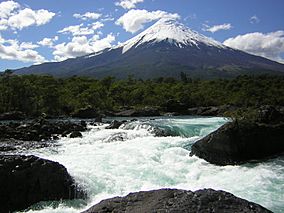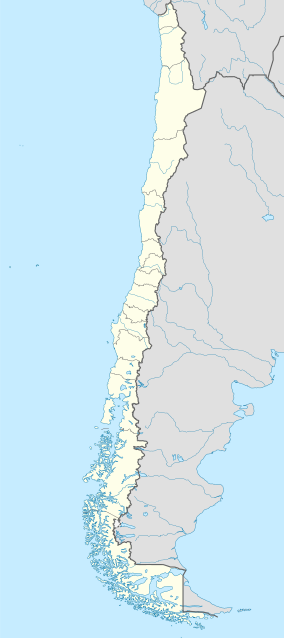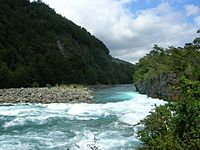Vicente Pérez Rosales National Park facts for kids
Quick facts for kids Vicente Pérez Rosales National Park |
|
|---|---|
|
IUCN Category II (National Park)
|
|

Petrohué Waterfalls (Saltos del Petrohué)
|
|
| Location | Los Lagos Region, Chile |
| Nearest city | Puerto Varas |
| Area | 2,530 km2 (977 sq mi) |
| Established | 1926 |
| Visitors | 332,334 (in 2012) |
| Governing body | Corporación Nacional Forestal |
Vicente Pérez Rosales National Park is a beautiful natural area in the Los Lagos Region of Chile. It's located in the Llanquihue Province. The park's main entrance is near Ensenada, about 64 kilometers (40 miles) from Puerto Varas.
This huge national park covers about 2,530 square kilometers (977 square miles). Most of it is nestled high in the amazing Andes mountains. It connects with other national parks like Puyehue National Park in Chile and Nahuel Huapi National Park and Lanín National Park in Argentina. Together, these parks form a massive protected area of nearly 15,000 square kilometers (5,792 square miles)!
The park is home to the stunning Todos los Santos Lake and much of the land around it. Water flows out of this lake at a place called Petrohué, forming the Petrohué River. A short distance downstream, you'll find the famous Petrohue Waterfalls, where the river rushes over volcanic rock. The park also includes parts of three impressive volcanoes: Volcan Osorno, Puntiagudo, and Tronador. These mountains are covered in snow all year, making the landscape truly breathtaking.
Contents
Climate and Weather in the Park
The weather in Vicente Pérez Rosales National Park can be quite wet! In the Petrohué area, about 700 meters (2,300 feet) above sea level, it rains a lot. The park gets around 4,000 millimeters (157 inches) of rain each year. Some parts, especially on the western slopes of the mountains, can get up to 5,000 millimeters (197 inches) of rain annually.
Why so much rain? The air usually moves from west to east. When this moist air hits the tall mountains, it's forced upwards. As it rises, it cools and releases a lot of rain. The eastern parts of the mountains usually get less rain.
The rainiest months are June, July, and August. The driest months are January, February, and March, which are summer in Chile. The average temperature in the lower parts of the park is about 11 to 12 degrees Celsius (52 to 54 degrees Fahrenheit). If you go higher than 1,000 meters (3,280 feet), you'll find snow for most of the year. During the warm summer, the highest daily temperatures can reach around 25 degrees Celsius (77 degrees Fahrenheit). Plants in the park grow for about six months of the year.
How the Park's Landscape Was Formed
The ground in Vicente Pérez Rosales National Park is mostly made of a hard rock called Granodiorite. This rock was formed from cooled magma deep inside the Earth. Over time, several large volcanoes have grown out of this rocky base.
- Osorno Volcano: At the western entrance, the Osorno volcano stands tall and perfectly shaped. Its peak is 2,652 meters (8,701 feet) high. Osorno grew on top of an older volcano called La Picada.
- Puntiagudo Volcano: This volcano has a very sharp peak, reaching 2,493 meters (8,179 feet).
- Tronador Volcano: This older volcano and its related structures were formed millions of years ago.
Besides volcanoes, huge glaciers also shaped the park during the Ice Age. These massive ice sheets moved down from the Tronador volcano, carving out valleys like the Todos los Santos valley. They scraped away almost all the soil and rocks that were there before. If you look closely at some exposed rocks, you can still see the scratches left by the stones carried by these ancient glaciers!
Volcanoes were still active as the glaciers melted away. Some scientists believe that Todos los Santos Lake and Llanquihue Lake were once one giant lake. The Osorno volcano grew so large that it eventually split the single lake into two. Later, lava flows from Osorno blocked the outlet of Todos los Santos Lake, causing its water level to rise. At the Petrohué Waterfalls, you can see the river flowing over one of these old lava flows.
Amazing Plants of the Park
The plants in Vicente Pérez Rosales National Park are part of the Valdivian temperate rain forests. This type of forest is found in cool, wet areas. The kinds of trees you see change depending on how high up you are and what kind of ground they grow on.
- Coihue: This is a very common and easy-to-spot tree, also known as Nothofagus dombeyi. It often grows with other trees like muermo (Eucryphia cordifolia) and tineo (Weinmannia trichosperma).
- Tique: In warmer spots near the lake, you might see thick groups of tique (Aextoxicon punctatum).
- Canelo: In very wet areas, canelo (Drimys winteri) is common.
- Myrtle Family: Trees and bushes from the myrtle family (Myrtaceae) are very diverse here, with nine different types. They usually grow where there's lots of water. One easy-to-spot tree is Temu (Luma apiculata), also called Chilean myrtle, which has bright orange bark.
- Proteaceae Family: This plant family has relatives in Australia and New Zealand. One example is Notro (Embothrium coccineum), also known as Chilean firebush, which has beautiful red flowers. Another is Avellano (Gevuina avellana), or Chilean hazel, which produces tasty nuts called avellanas.
Among the smaller plants, the giant pangue (Gunnera tinctoria), also called Chilean rhubarb, is everywhere. It can grow up to 2 meters (6.5 feet) tall and has huge leaves. The stem is edible, and the root was once used to dye wool brown. Pangue is often one of the first plants to grow in areas where landslides have cleared the land.
Many plants in this forest rely on birds, especially hummingbirds, to help them make seeds. These flowers are often bright red and yellow, have no smell, and are shaped like tubes that hang down, perfect for a hummingbird's beak!
Unfortunately, some plants that don't belong here have started to grow wild in the park. One example is Spanish Broom (Spartium junceum). It has pretty yellow flowers but is actually harmful to animals and takes over areas, especially around the Osorno volcano.
Animals of the Park
About 30 different kinds of mammals live in Vicente Pérez Rosales National Park. Many of them are shy and hard to spot. This park, along with the nearby Puyehue, Nahuel Huapi, and Lanin parks, provides a home for the puma (Puma concolor). The pumas here are relatively small, usually weighing about 30 to 40 kilograms (66 to 88 pounds). They often hunt the pudu (Pudu puda), a tiny, shy deer that lives alone in the forest.
You might also see a huiña (Leopardus guigna), which looks like a small, wild cat but is actually a type of tiny ocelot. For dog-like animals, there's the chilla (Pseudalopex griseus), which looks like a small fox but isn't a true fox.
Some animals that were brought to the park from other places are causing problems for the natural balance. These include the European red deer (Cervus elaphus) and the wild boar (Sus scrofa). They can damage the forest by eating young plants.
The park is also home to three native animals from the weasel family (Mustelidae):
- Molina's hog-nosed skunk (Conepatus chinga)
- Lesser grison (Galictis cuja)
- Southern river otter (Lontra provocax), which is an endangered species.
Unfortunately, another weasel-like animal, the American mink (Mustela vison), was brought here and has caused a lot of harm to the park's animals, especially birds that nest on the ground or in floating reeds.
Many different kinds of rodents live in the park. Some of the larger ones include the coipo (Myocastor coypus), a web-footed animal that lives along lake and river banks, and Wolffsohn's viscacha (Lagidium wolffsohni), which prefers to live above the tree line. Smaller rodents that scientists study include the Chilean climbing mouse (Irenomys tarsalis) and the long-clawed mole mouse (Geoxus valdivianus).
The park also has two types of marsupial mammals, which are animals that carry their young in a pouch.
- Monito del monte (Dromiciops gliroides): This small animal lives partly in trees. It's interesting because it seems more closely related to marsupials from Australia than to other marsupials in the Americas!
- Long-nosed shrew opossum (Ryncholestes raphanurus): This marsupial was first described by scientists in 1923.
About 80 different kinds of birds can be seen in the park. Some live here all the time, while others visit seasonally.
- Chucao tapaculo (Scelorchilus rubecula): This bird is easy to hear, and sometimes see.
- Black-throated huet-huet (Pteroptochos tarnii): This is a special bird that birdwatchers love to find in this park.
- Torrent duck (Merganetta armata): You might spot this duck near the Petrohué Waterfalls.
- Firecrown hummingbird (Sephanoides sephaniodes): This hummingbird is common and easy to see.
Sadly, the native fish in Todos los Santos Lake have been affected by the introduction of several types of trout and salmon. Now, fishing for these introduced species is a popular activity in the park.
Among the insects, two cool beetles are worth mentioning: the large antlered scarab beetle (Chiasognathus granti) and the shiny colored longhorn beetle (Cheloderus childreni).
Park Services and Activities
The Corporación Nacional Forestal (CONAF) manages Vicente Pérez Rosales National Park and other national parks in Chile. CONAF has offices in places like Ensenada, Petrohué, and Peulla. They also have control points at the Petrohué Waterfalls and at different entrances to the Osorno volcano.
There's a camping area run by CONAF in Petrohué. CONAF has also created several hiking trails for visitors to enjoy:
- Sendero Paso Desolación: This trail is on the eastern side of the Osorno volcano. It's 12 kilometers (7.5 miles) long and goes up to 1,100 meters (3,600 feet) high.
- Sendero Laguna Margarita: This trail in Peulla is 8 kilometers (5 miles) long.
Todos los Santos Lake has been part of a travel route over the Andes mountains for hundreds of years. In the late 1800s, regular boat and tourist services started between Puerto Montt and the park, along with hotels. Today, there are good quality hotels at Petrohué and Peulla, which are access points to the lake. You can also find lodges for people who love to fish near the Petrohué waterfalls and river. In Petrohué, you can even rent motorboats from private companies.
See also
 In Spanish: Parque nacional Vicente Pérez Rosales para niños
In Spanish: Parque nacional Vicente Pérez Rosales para niños




